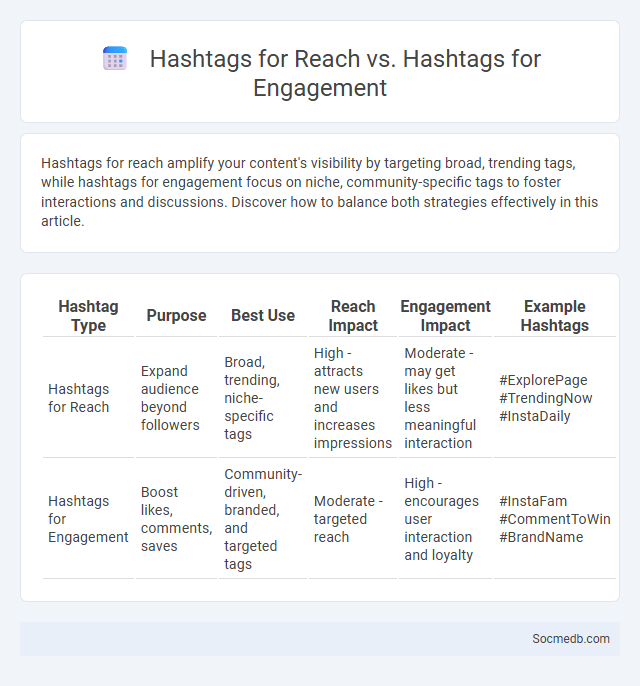
Photo illustration: Hashtags for Reach vs Hashtags for Engagement
Hashtags for reach amplify your content's visibility by targeting broad, trending tags, while hashtags for engagement focus on niche, community-specific tags to foster interactions and discussions. Discover how to balance both strategies effectively in this article.
Table of Comparison
| Hashtag Type | Purpose | Best Use | Reach Impact | Engagement Impact | Example Hashtags |
|---|---|---|---|---|---|
| Hashtags for Reach | Expand audience beyond followers | Broad, trending, niche-specific tags | High - attracts new users and increases impressions | Moderate - may get likes but less meaningful interaction | #ExplorePage #TrendingNow #InstaDaily |
| Hashtags for Engagement | Boost likes, comments, saves | Community-driven, branded, and targeted tags | Moderate - targeted reach | High - encourages user interaction and loyalty | #InstaFam #CommentToWin #BrandName |
Understanding Hashtags: Reach vs Engagement
Hashtags play a pivotal role in social media strategy by enhancing content visibility and categorizing posts within specific topics or trends. Reach measures how many unique users see a post, often increased by using popular or trending hashtags that tap into broad audiences. Engagement, however, reflects the quality of interactions--likes, comments, shares--with more niche or targeted hashtags fostering deeper connections and active participation from a relevant community.
The Role of Hashtags in Social Media Marketing
Hashtags in social media marketing enhance content discoverability by categorizing posts, increasing audience reach, and driving engagement across platforms like Instagram, Twitter, and LinkedIn. Strategic use of trending and niche-specific hashtags improves brand visibility and fosters community interaction, leading to stronger customer connections and higher conversion rates. Brands leveraging analytics tools to identify effective hashtags optimize campaign performance and boost social media ROI.
What Are Hashtags for Reach?
Hashtags are keywords or phrases preceded by the "#" symbol used on social media platforms to categorize content and increase its discoverability. They help to expand reach by connecting posts to trending topics, themes, or communities, making it easier for users interested in specific subjects to find related content. Effective use of popular and relevant hashtags can significantly boost engagement rates and broaden audience exposure across platforms like Instagram, Twitter, and TikTok.
What Are Hashtags for Engagement?
Hashtags for engagement are strategic keywords or phrases preceded by the "#" symbol, designed to increase the visibility and reach of your social media posts. By categorizing content and making it discoverable, hashtags help you connect with targeted audiences and boost interactions such as likes, comments, and shares. Using relevant and trending hashtags can significantly enhance your social media engagement and grow your online community.
Key Differences Between Reach and Engagement Hashtags
Reach hashtags amplify content visibility by making posts discoverable to a broader audience beyond current followers, increasing impressions and potential new followers. Engagement hashtags target niche communities with the goal of fostering interactions such as likes, comments, and shares, enhancing user involvement and content relevancy. Utilizing a strategic mix of high-reach and high-engagement hashtags optimizes social media performance by balancing audience expansion and active participation.
How to Identify Effective Reach Hashtags
Effective reach hashtags are identified by analyzing hashtag engagement metrics such as reach, impressions, and interactions within your target audience. You should use tools like Instagram Insights, Twitter Analytics, or third-party platforms like Hashtagify to track hashtag performance and relevance. Selecting hashtags that align with your content and industry trends maximizes exposure and connects Your posts to users most likely to engage.
How to Select Engagement-Driven Hashtags
Select engagement-driven hashtags by researching popular, niche-specific tags that align with your content and audience interests. Analyze hashtag performance metrics such as reach, interaction rate, and follower demographics to ensure maximum visibility and engagement. Incorporate a mix of trending, community, and branded hashtags to optimize Your social media posts for better discoverability and higher engagement.
Building a Balanced Hashtag Strategy
Building a balanced hashtag strategy involves combining broadly popular hashtags with niche-specific tags to maximize reach and engagement on social media platforms like Instagram, Twitter, and TikTok. Using 10 to 15 relevant hashtags that reflect trending topics and specific community interests can enhance content visibility and audience targeting. Monitoring hashtag performance through analytics tools such as Sprout Social or Hootsuite helps refine strategy by identifying the most effective tags for driving user interaction and brand growth.
Measuring Hashtag Performance and Analytics
Measuring hashtag performance involves tracking key metrics such as reach, impressions, engagement rate, and hashtag usage frequency across social media platforms like Instagram, Twitter, and Facebook. Tools like Sprout Social, Hootsuite Analytics, and Brandwatch provide in-depth insights into hashtag effectiveness by analyzing audience demographics, sentiment, and post virality. Consistent evaluation of these analytics enables marketers to optimize hashtag strategies, improve content targeting, and boost brand visibility in digital campaigns.
Best Practices for Hashtag Strategy Optimization
To maximize your social media reach, use a mix of popular and niche hashtags relevant to your content and audience. Research trending hashtags in your industry and analyze competitors' successful tags to refine your strategy. Consistently monitor hashtag performance metrics to adjust and improve your hashtag usage for better engagement and visibility.
 socmedb.com
socmedb.com